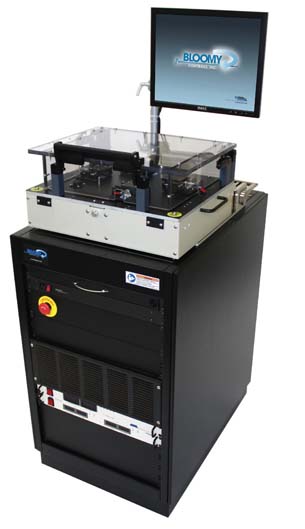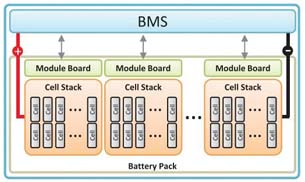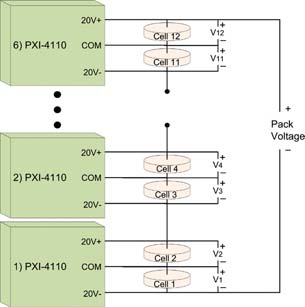NI’s LabVIEW Enables Battery Testing Platform
Computing that Will Change the World, First Place: Bloomy Controls' Battery Management System is poised to change the world by enabling better electric and hybrid automobiles.
Latest News
December 1, 2009
By Peter Varhol
 Bloomy Controls used LabVIEW to design its new battery management system. |
While engineering innovation can be about breakthrough products and exciting solutions, it can also be about enabling important new technologies—technologies that will in fact change the world through their value in enabling new ways of working and living.
Bloomy Controls of Marlborough, MA, is making strides in the development of an enabling technology that makes it possible to test battery systems for electric and hybrid automobiles. In a world where green technologies are becoming critically more important in ensuring the future of the planet, that’s no small feat. Because of its significance to the automotive industry, its contribution to enabling green technologies, and its unique design and simplicity, the Bloomy Controls Battery Management System testing platform is the winner of the IT and computing category of Desktop Engineering’s Change the World Challenge.
The rapid growth of the hybrid-electric vehicle industry has presented many new opportunities for product testing and measurement. Many of these opportunities require production-level test systems with short design times, high accuracy, and strong reliability. One opportunity, identified by Bloomy Controls, involved the production testing of battery management systems (BMSs) for lithium-ion battery packs used in plug-in hybrid electric vehicles.
BMSs handle all of the monitoring, control, and safety circuitry and functioning of battery packs and battery control systems, including accurately monitoring battery cell charges, balancing voltages between cells to maintain a constant voltage across packs, managing charging and discharging, and protecting the system from over-voltage and over-current conditions for packs of up to 12 battery cells in series.
In addition, BMSs monitor battery and support system temperatures, handle system power management by engaging in sleep modes to reduce current draw, and communicate with external controllers to provide system feedback. While there are several types of battery management boards, including individual pack balancing and monitoring boards and system control boards, they can all be considered BMSs for the purposes of the Bloomy Controls testing platform.
One key with the Bloomy Controls Battery Management System tester is that it is able to simulate a set of loads as a part of the testing process. This is an essential feature, as it is not possible to test battery systems in a manufacturing environment with actual automobiles. In fact, in some cases the target vehicle might not even exist yet; it might still be in the design phase, and need a BMS as an integral part of the design. The BMS testing platform has to be able to simulate loads and stresses that are typical of what an automobile might do during the course of operation.
 The Bloomy Controls BMS block diagram illustrates the modular approach to testing battery cells (up to 12 per pack) in a series configuration. |
According to Project Manager Robert Cornwall, the idea grew out of existing testing systems designed and built by Bloomy Controls. By moving into battery system testing, the company has been able to leverage existing skills and technology into an important piece of relevant technology.
The BMS testing system (they don’t have a really catchy name for it) provides for the ability to test battery systems coming off of a production line, prior to their integration into the automotive systems. It ensures that manufactured BMSs can handle battery systems on electric and hybrid vehicles without failing.
The BMS testing system employs a user interface built using LabVIEW, a software package from National Instruments that provides the ability to graphically build both a user interface and a flow for the testing process. LabVIEW enabled the rapid development of the user interface and underlying software in order to run and administer the system.
The Bloomy Controls BMS testing platform provides a way for manufacturers of battery systems for fully electric or hybrid automobiles to easily ensure that their products are fully tested, reliable, and ready to be used in vehicles. It is modular and adaptable to different types of BMSs, enabling the company to quickly reconfigure as battery technology changes.
The BMS Testing Platform Details
The design of the testing platform started with the Bloomy Controls PXI-based universal test system. Using this platform, project engineer Grant Gothing explained that the design team produced a flexible, high-accuracy base platform consisting of a standard mass interconnect capable of testing multiple models of BMS circuit boards by using interchangeable fixtures. “We centered our system around six NI PXI-4110 triple-output programmable DC power supplies, which we used to simulate a pack of up to 12 lithium-ion cells,” he described.
 This setup shows a system built around six NI PXI-4110 programmable DC power supplies. |
The design team also multiplexed a high-accuracy NI PXI-4071 digital multimeter (DMM) to measure voltages within the required millivolt specifications, and added an NI PXI-6221 M Series data acquisition DAQ module to provide analog outputs, TTL digital I/O, and higher-speed analog input measurements. The group implemented the NI PXI-6514 industrial digital I/O module to read switches and actuate fixture relays. In addition to the PXI hardware, the company used fixed power supplies and programmable high-voltage and high-current supplies to provide additional system power as required by the testing specifications.
Finally, the engineers provided a USB connection to the fixtures to allow flexible addition of other UUT-specific communications and peripheral hardware on a per-model basis. The design team housed all of the hardware in a standard 19 in. rack. The test rack provided a system capable of making any measurement and supplying any source required by a BMS board.
As mentioned earlier, the software operating the BMS was written using the LabVIEW visual programming environment. It contained all test parameters in a configuration file to allow the customer to update, tighten, or loosen test specifications without making software changes. In addition, the group stored all of the data acquisition channels and tasks in a separate configuration file, which allowed hardware or wiring changes to be made without affecting the underlying software.
Also, because the user interface is designed for a manufacturing environment, it requires minimal operator interaction. To operate, the test technician simply opens the safety lid of the fixture, scans the barcode serial number of the unit to test, then closes the fixture for the test to start during standard operation. When testing is complete, the test result is shown, test data is logged to file, and any failed tests are highlighted for the technician.
By using a modular approach to design, along with interchangeable components, the base system can accommodate testing a wide range of BMS models, supporting many different potential battery and automotive designs. This method reduces cost and new fixture design time and makes it cost-effective to test even small quantities such as R&D prototypes. The NI PXI platform coupled with LabVIEW delivered the ideal tools to quickly design and build a BMS test platform that is flexible enough to test multiple customer products, and accurate enough to meet or exceed BMS testing requirements.
More Info:
Bloomy Controls
Contributing Editor Peter Varhol covers the HPC and IT beat for DE. His expertise is software development, math systems, and systems management. You can reach him at [email protected].
Subscribe to our FREE magazine, FREE email newsletters or both!
Latest News
About the Author
Peter VarholContributing Editor Peter Varhol covers the HPC and IT beat for Digital Engineering. His expertise is software development, math systems, and systems management. You can reach him at [email protected].
Follow DE





